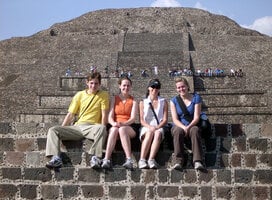High School Abroad in Mexico
Frida Kahlo, adventures to Aztec ruins, lively festivals, beautiful beaches, and delicious food have been inspiring people to come to Mexico for years.
Spend time abroad while in high school to attend classes alongside Mexican students while living with a host family to master your Spanish language skills. Volunteer for a summer in Oaxaca with development organizations. Study wildlife conservation while spending a few weeks working with sea turtle conservation efforts. There are all sorts of programs for students with all interests.
Mexico is great for students who want to practice their Spanish with a host family, enjoy the arts and music, and care about conversation and public health.
If you're interested in doing high school abroad in Mexico, you can choose from:
- A semester or full year exchange
- A summer study or volunteer program
High School Exchange
Spend a few months to a year living with a host family, while attending school alongside Mexican students. In Oaxaca, you'll be closer to the mountains as well as more indigenous traditions. Students who want a more metropolitan feel can spend their time in the capital, Mexico City.
While attending high school abroad in Mexico, students can take Spanish language courses and electives about Mexican history, art, marine biology, in additional to math and science classes. Students will get to experience Mexican life outside of the classroom too, at soccer games and festivals.
Summer Study Abroad
What better way to experience a new country, than to spend a summer abroad? Embark on a language immersion program and improve your Spanish. Spent 1-3 months volunteering with a development organization in Oaxaca or with sea turtles at the Campamento Tecoman biological station for a few weeks. Road trip through Arizona, Utah, New Mexico and Mexico on an experiential learning expedition through indigenous America. Or get to learn about marine biology as you travel through different Mexican coastal cities along the Baja Peninsula.
The variety of summer programs for high schoolers in Mexico allow students form any background to find something that suits their goals.
Student Visa
US citizens may enter and stay in Mexico for up to 180 days without a visa. Full year exchange programs will require a visa, but program providers will help students with that process.
Upon arriving in Mexico, travelers will receive an entrance paper. Students should keep this with their passport, as officials will ask to see it when they depart Mexico after their program.
Housing
Students who study abroad in Mexico during a semester or full year exchange will be paired up with a host family. Contrarily, students who do summer study or volunteer abroad programs will stay in hotels, ranches, with a temporary host family, eco-lodges, or camping depending on the program.
Costs
Most program fees cover two meals a day, housing, visa fees and program activities, so students should plan to budget for any extra activities they plan to do in Mexico. Affordable airlines like Southwest and Frontier now offer flights from major cities to Mexico for around $300 each way.
An average lunch can range between 60-80 Mexican Pesos, which is equivalent to less than $5. Dinner ranges from 200-300 Mexican Pesos, which is equal to $10-15.
Program fees vary depending on city, program, and duration of your time abroad. Semester programs range from $5,650 - $14,000. Year long programs cost between $7,400 - $14,495. Summer programs between 1-3 months range between $1,030 - $4,700.
Packing Tips
Unlike the US, Mexico only has two seasons: dry and wet. Dry season lasts from October through April and the wet season lasts from May until September, and temperatures are usually in the 70s and 80s year round.
Here are some things to not leave at home:
- Rain jacket
- Sneakers you don't mind getting dirty
- Plainer clothing that can be mixed and matched, and layered.
- Sandals
Food
Food is an essential part of Mexican culture and social life, as often times large groups of families and friends gather to enjoy a meal together. We're all familiar with some of the staples of Mexican cuisine, like tacos and quesadillas, but while you're in Mexico you should venture out and try some new dishes too! The BBC recommends these Top 10 Foods to Try in Mexico.
Health
Traces of the Zika virus have been found in Mexico. To learn more about Zika and how to avoid getting infected, read the Washington Post's article on Zika precautions.
Prior to entering Mexico, it is recommended that travelers get vaccinated for Hepatitis A, Hepatitis B, Typhoid, Tuberculous, and Rabies. For more information, refer to The Travel Vaccination Companion.
Safety
As far as safety goes, students should be attentive to the possibility of being pick-pocketed. To avoid the chance of this happening to you, we recommend wearing a traveler's belt under your clothing, so that you can store important documents like a copy of your passport and cash, and being aware of your bags at all times.
Also be cautious of taking unmarked taxis -- especially in Mexico City.

















